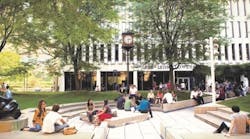Design Urban Campuses to Engage with the Community
Large cities provide colleges and universities located within their boundaries a dynamic place in which to situate curricular experiences. For these institutions, a city isn’t just a context to study, but rather it’s a cause to engage and shape.
Urban campuses are firmly embedded in their surrounding communities. Unlike a college town or suburban campus where a college or university is often a sole dominant institution, urban campuses exist alongside many other institutions, organizations, neighborhoods and people who might not be affiliated with the college or university environment but are impacted by its planning decisions.
Some urban campuses exist behind gates and walls. Others are spread throughout neighborhoods, and some exist as neighborhoods unto themselves or as campus districts.
Urban campuses today are cognizant of their role as stewards of city land and neighborhood space.
In many cases, institutions take a more surgical approach to campus planning. However, when opportunities arise for larger-scale land use change and institution building, the legacy of earlier generations of land use policy compels urban campuses to tread lightly and engage stakeholders as caring citizens.
Learning, research and the practice of scholarship are community endeavors. Communities are often self-generating and self-sustaining social and professional bonds through which shared goals are achieved. Colleges and universities nurture a range of communities within their institutional structures.
The motivation for urban campuses to create a sense of community through their physical presence in cities should begin with two key questions:
1. Who Are the Communities We’re Serving?
For urban campuses (and arguably, for many larger colleges and universities regardless of location), the answer is often a mix of local, state, national and global stakeholders.
On the one hand, urban campuses engage with local- and state-level stakeholders because of the opportunities for visible impact of an institution’s teaching and research on dense populations of people who are in close geographic proximity to these activities. On the other hand, the social, economic and political capital that stems from national and international collaborations brings prestige to colleges and universities that raise the profile of the institution and the local campus environment.
Related: What the Largest IAQ Experiment Shows About Your Indoor Air
Not to mention, the decadeslong decline in state and local funds for higher education have necessitated broader engagement with possible funding sources from a range of potentially global sources.
In other words, institutional prestige, legitimacy and funding for many urban campuses is a function of the institution’s global reputation, but an urban campus’s institutional impact is widely experienced at the most local scale.
The way an urban college or university answers this first question in a manner relevant to its respective institution will affect macro level planning decisions. These include the development of master plan strategies, major land use strategies, the formation of institutional partnerships, and decisions concerning academic programs and how they engage with the institution’s various stakeholders in alignment of a broader campus mission.
2. How Are We Serving Our Stakeholders?
Once institutional leaders articulate who they need to serve at local, state, national and international levels, then decisions are made concerning the planning and design of the campus environment comes into play.
The way an urban college or university answers this second question will affect micro-level planning decisions. These include the programming of campus spaces, the providing of access to spaces for institutional participants and guests, service/UX design elements and the sharing of institutional space with other partners or organizational entities.
5 Strategies for Planning and Designing Urban Campuses
Based on how higher education leaders address the questions posed above, the following planning and design strategies may be considered:
1. Shared amenities or services with other institutions.
The density that often defines urban campuses can lessen the supply of available real estate and raise its costs. However, this same density also brings opportunities to share amenities and services.
The Auraria Higher Education Center in Denver is a notable example of a public organization that manages the real estate and shared services for three state universities located in close geographic proximity in the city’s center.
On a smaller scale, the University Center in Chicago is a university residential development that provides campus housing for students at Columbia College Chicago, Roosevelt University and DePaul University in a single facility.
2. Create publicly approachable space.
Urban campuses are often located in areas of heavy pedestrian and vehicle traffic. Or they occupy otherwise highly prominent “postcard locations.” Whatever functions occupy a given campus building, assume that more people will pass by the space compared to a comparable suburban or small town campus building.
This is especially true for spaces like business incubators, art galleries and cultural spaces, which are meant to attract visitors or users from collaborating institutions. Some of the newest urban campuses like Cornell Tech in New York City are designing showcase buildings and public spaces that depart from traditional campus planning norms and, in doing so, invite critical reflection on the future of higher education.
3. Leverage the landscape.
There are a number of ways that an urban campus can integrate within the grid or layout of the cities in which they are located. The use of natural or naturalistic elements to define the campus and signal is approachability is a way for urban campuses to create a sense of place.
At the University of Washington’s West Campus in Seattle, large elm trees define a plaza and residential space on the campus, which includes publicly accessible connector plazas integrated with the street grid.
4. Support local housing policy.
In some cities and neighborhoods, urban academic campuses are catalysts for economic and civic revitalization. In several Rust Belt cities such as Buffalo, NY; Detroit; and Cleveland, local universities - in partnership with other major employers - fund various incentive programs to encourage employees to purchase and live in homes in nearby neighborhoods. These programs are often structured in the form of home purchase assistance, loan incentives or home renovation funds.
5. Move back-of-house functions off the grid.
Because of the sizable commercial real estate markets in these cities, urban campuses often have more options for leasing space than they would if they were located in smaller markets.
By prioritizing central campus spaces for academic functions related to teaching, research and business engagement, urban campuses can relocate non-academic functions such as financial operations and other back-of-house functions to leased space elsewhere in the city.
In fact, this strategy can create adjacencies to other partner organizations that may provide benefits to these back-of-house functions that they might not otherwise enjoy if they were embedded within academic space.
Peter Bacevice, PhD, is director of research at HLW and Bennet Dunkley, AIA, is a principal at HLW who leads the firm’s higher education practice.
HLW is a leading international full-service planning, architecture and design firm that is building the future from skyscrapers, to the workplaces of today’s most cutting-edge companies. Sustaining a successful practice for over 130 years, HLW remains a strong, innovative and progressive organization with a diverse portfolio of projects from broadcast and media, financial corporations, technology, academic institutions and multi-family and mixed-use buildings.
Two hand-picked articles to read next:


